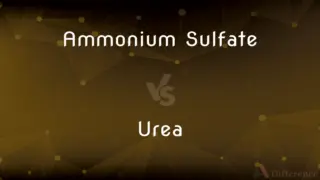Life Science vs. Physical Science — What's the Difference?
By Tayyaba Rehman — Published on November 15, 2023
Life Science studies living organisms and life processes, while Physical Science examines non-living systems and the laws of nature.

Difference Between Life Science and Physical Science
Table of Contents
ADVERTISEMENT
Key Differences
Life Science delves deep into the intricacies of living organisms. From cellular mechanisms to vast ecosystems, it endeavors to uncover the secrets of life. Physical Science, in contrast, delves into the non-living realm, probing the properties and behavior of matter and energy.
Within Life Science, diverse fields such as biology, botany, and zoology exist, focusing on various aspects of life. On the other hand, Physical Science branches into disciplines like physics and chemistry, which examine the universe's fundamental principles.
Life Science can explain how genes dictate traits, how species evolve, or how ecosystems maintain balance. In comparison, Physical Science can elucidate how atoms bond, how light travels, or how energy transforms.
To understand the human body's function, one would turn to Life Science, examining anatomy or physiology. Conversely, to grasp the mechanics of a moving car, one would consult Physical Science, particularly physics.
Comparison Chart
Primary Focus
Living organisms and life processes.
Non-living systems and laws of nature.
ADVERTISEMENT
Sub-disciplines
Biology, botany, zoology, etc.
Physics, chemistry, astronomy, etc.
Examples of Study
Genes, species evolution, ecosystems.
Atomic bonding, light propagation, energy transformation.
Application
Human health, conservation, agriculture.
Technology, mechanics, materials science.
Methods
Dissection, cell culture, DNA sequencing.
Experimentation, mathematical modeling, spectroscopy.
Compare with Definitions
Life Science
Life Science explores ecosystems and their dynamics.
Conservationists use Life Science to preserve biodiversity.
Physical Science
Physical Science investigates energy and its transformations.
Understanding solar power requires knowledge in Physical Science.
Life Science
Life Science helps in understanding human biology and health.
Life Science research has paved the way for many medical breakthroughs.
Physical Science
Physical Science underpins many technological advancements.
Innovations in smartphones owe a lot to Physical Science research.
Life Science
Life Science focuses on living organisms.
Her interest in plants led her to study Life Science.
Physical Science
Physical Science analyzes the principles of the universe.
The study of gravity is a key aspect of Physical Science.
Life Science
Life Science examines the genetic foundation of organisms.
Genetic engineering is a cutting-edge field in Life Science.
Physical Science
Physical Science studies matter and its interactions.
He was fascinated by atoms, driving him to study Physical Science.
Life Science
Life Science investigates processes of life.
Through Life Science, we understand how cells function.
Physical Science
Physical Science delves into the behavior of materials.
Her work in Physical Science led to the discovery of a new alloy.
Common Curiosities
What does Life Science primarily focus on?
Life Science is centered on living organisms and life processes.
Can you name a few sub-disciplines of Life Science?
Yes, they include biology, botany, and zoology, among others.
Which fields fall under Physical Science?
Disciplines like physics, chemistry, and astronomy are branches of Physical Science.
How does Life Science contribute to society?
It plays a significant role in human health, conservation efforts, and agriculture.
Does Life Science study viruses?
Yes, the study of viruses is a branch of Life Science called virology.
What's the core area of study in Physical Science?
Physical Science examines non-living systems and the fundamental laws of nature.
What are some applications of Physical Science?
It's crucial for technology development, understanding mechanics, and materials science.
Is anthropology a part of Life Science?
Yes, anthropology, especially biological anthropology, can be considered a part of Life Science.
How does Physical Science help in daily life?
Physical Science explains phenomena like electricity, heat, and light, impacting our daily lives.
Are mathematics and computer science a part of Physical Science?
While they're not core disciplines of Physical Science, they often assist in its methodologies and research.
Share Your Discovery

Previous Comparison
Steel vs. Cast Iron
Next Comparison
Ammonium Sulfate vs. UreaAuthor Spotlight
Written by
Tayyaba RehmanTayyaba Rehman is a distinguished writer, currently serving as a primary contributor to askdifference.com. As a researcher in semantics and etymology, Tayyaba's passion for the complexity of languages and their distinctions has found a perfect home on the platform. Tayyaba delves into the intricacies of language, distinguishing between commonly confused words and phrases, thereby providing clarity for readers worldwide.












































